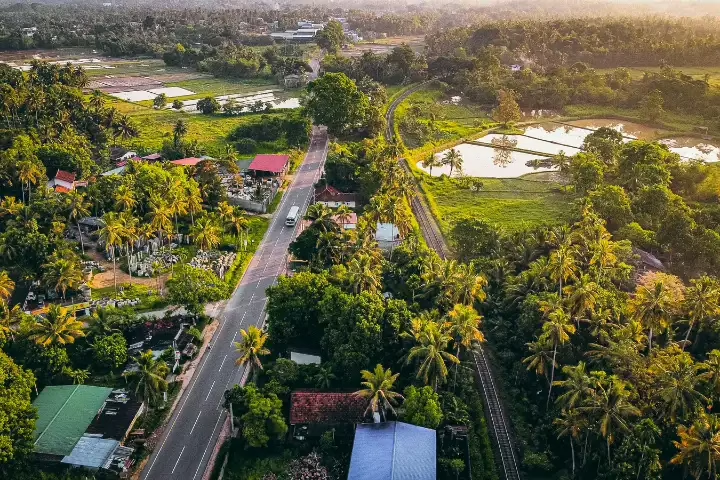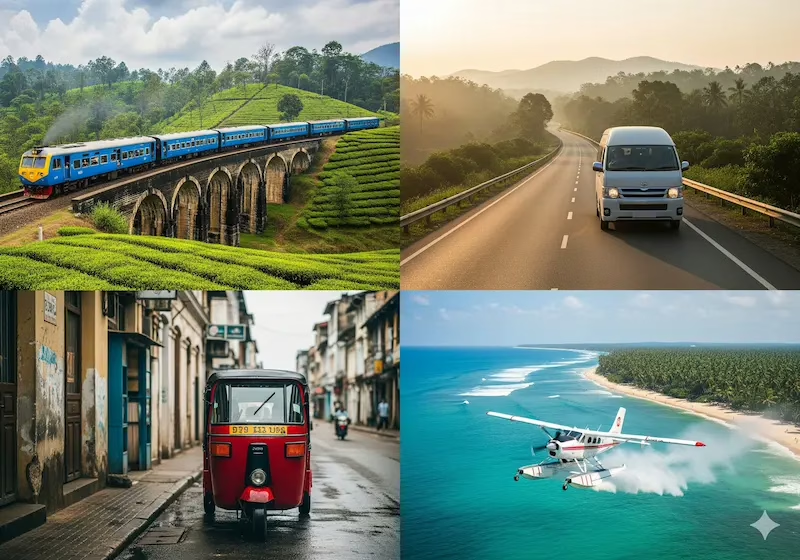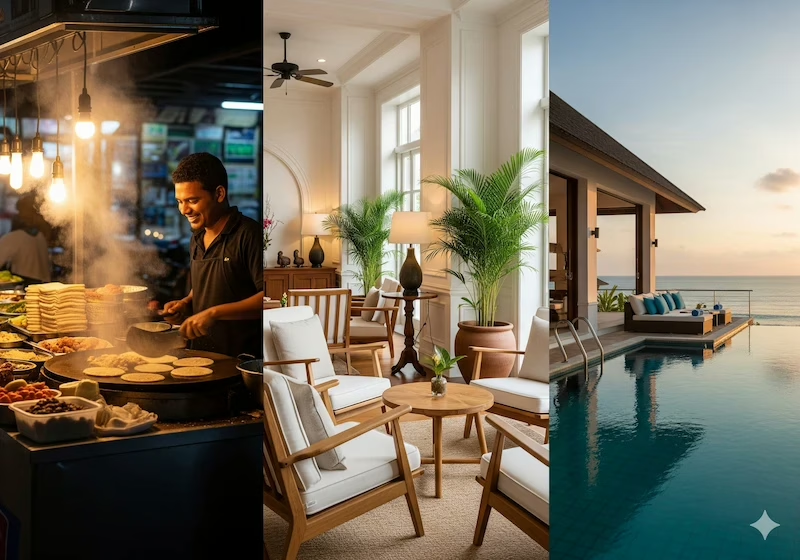TL;DR
Europeans often have misconceptions about Sri Lanka that can impact their travel experience. This article debunks seven major myths:
- Distances – The island is smaller than you think, allowing diverse experiences within short travel times
- Weather patterns – It’s not always monsoon season everywhere; strategic planning ensures good weather
- Costs – Budget-friendly options exist alongside luxury experiences to suit any travel style
- Safety concerns – Generally very safe for tourists with proper precautions and local awareness
- Cultural expectations – English communication and cultural barriers are more manageable than assumed
- Food assumptions – Cuisine extends far beyond spicy curries with incredible variety and adaptability
- Transportation realities – Multiple reliable options exist despite initial concerns about chaos
These Sri Lanka travel tips will help you plan a more informed and enjoyable trip to this incredible island nation.

Sri Lanka, the pearl of the Indian Ocean, continues to captivate European travelers with its stunning landscapes, rich culture, and warm hospitality. However, many Europeans arrive with preconceived notions that can significantly impact their travel experience. These Sri Lanka travel tips will help debunk the most persistent myths and ensure your journey to this magnificent island is everything you hoped for and more.
As someone who has witnessed countless European visitors discover the reality of Sri Lankan travel, I’ve compiled the seven most common misconceptions that can make or break your adventure. Understanding these myths before you pack your bags will transform your trip from potentially frustrating to absolutely magical.
Myth 1: Sri Lanka is Huge and You Need Weeks to See Anything Meaningful
The Reality Check
One of the biggest surprises for European visitors is Sri Lanka’s compact size. At roughly 65,610 square kilometers, the entire country is smaller than Ireland and about the size of Bavaria. This means you can witness incredible diversity – from pristine beaches to misty mountains, ancient ruins to bustling cities – within remarkably short distances.
Local Travel Tips Sri Lanka: Distance Realities
Many Europeans plan their itineraries assuming they’ll need days to travel between destinations. The truth is, you can drive from Colombo to Kandy (the cultural capital) in just 3-4 hours, or reach the southern beaches in 2-3 hours. Even the northern city of Jaffna, once considered remote, is accessible within 5-6 hours by road.
A well-planned 7-10 day trip can cover the cultural triangle (Anuradhapura, Polonnaruwa, Sigiriya), the hill country (Kandy, Nuwara Eliya), and the southern coast (Galle, Mirissa). The key is understanding that while distances are short, travel times can vary due to road conditions and traffic, especially during peak hours.
Myth 2: It’s Always Monsoon Season Somewhere, So Weather is Unpredictable
Understanding Sri Lanka’s Climate Patterns
Europeans often assume Sri Lanka has chaotic, unpredictable weather year-round. The reality is that Sri Lanka has two distinct monsoon seasons affecting different parts of the island, making it possible to find good weather somewhere almost any time of year.
Local Travel Tips Sri Lanka: Weather Windows
The southwest monsoon (May to September) primarily affects the western and southwestern coasts, while the northeast monsoon (October to January) impacts the eastern and northern regions. This creates fantastic opportunities for strategic travel planning.
For instance, when Europe is experiencing winter (December to March), Sri Lanka’s west and south coasts enjoy their dry season – perfect beach weather. Meanwhile, if you visit during European summer (June to August), the east coast offers brilliant sunshine while the west might be experiencing rains.
The hill country maintains a relatively stable, cooler climate year-round, making destinations like Kandy and Ella excellent any time. These Sri Lanka travel tips about weather patterns can help you avoid disappointment and maximize your experience.
Myth 3: Sri Lanka is Either Extremely Cheap or Surprisingly Expensive
The Pricing Reality
Many Europeans arrive with confused expectations about costs, having heard conflicting reports about whether Sri Lanka is a budget destination or an expensive one. The truth lies in understanding the diverse pricing spectrum available.
Budget-Friendly Options
Local guesthouses can cost as little as $10-15 per night, street food meals under $2, and local bus transportation for pennies. A backpacker can comfortably travel on $20-30 per day, making Sri Lanka incredibly affordable compared to European standards.
Mid-Range Comfort
Boutique hotels, guided tours, and restaurant dining typically range from $50-100 per day per person – still excellent value for Europeans accustomed to higher prices at home.
Luxury Experiences
High-end resorts, private drivers, and exclusive experiences can easily cost $200-500+ per day, rivaling luxury destinations anywhere in the world.
The key insight from these Sri Lanka travel tips is that you have complete control over your budget, with authentic experiences available at every price point.
Myth 4: Sri Lanka Isn’t Safe for European Tourists
Addressing Safety Concerns
Following the 2019 Easter attacks, many Europeans developed exaggerated safety concerns about Sri Lanka. While any traveler should exercise normal precautions, current safety levels for tourists are excellent.
Local Travel Tips Sri Lanka: Safety Realities
The Sri Lankan government has significantly enhanced security measures at tourist sites, hotels, and transportation hubs. Crime against tourists is relatively rare, and violent crime is uncommon. The biggest safety concerns are typically minor issues like petty theft in crowded areas or traffic-related incidents.
Local people are generally very helpful and honest with tourists. However, like anywhere, use common sense: don’t flash expensive items unnecessarily, be aware of your surroundings, and trust your instincts.
Natural hazards like strong ocean currents or wildlife encounters (elephants, leopards) require more attention than security concerns. Following local advice and using reputable tour operators mitigates these risks effectively.
Myth 5: Everyone Speaks English Fluently
Language Expectations vs. Reality
Many Europeans assume English proficiency is universal in Sri Lanka due to its colonial history. While English is widely spoken in tourist areas, the reality is more nuanced.
Communication Insights
In tourist hotspots, major hotels, and among educated professionals, English communication is generally excellent. However, in rural areas, local markets, or with older generations, Sinhala or Tamil are primary languages.
Learning a few basic Sinhala phrases (“Ayubowan” for hello, “Bohoma sthuti” for thank you) goes a long way in building connections. Most importantly, patience and gestures can bridge communication gaps effectively.
Tourist-focused businesses typically have English-speaking staff, but having translation apps or key phrases written down can be helpful for authentic local experiences.
Myth 6: The Food is Just Spicy Curry
Culinary Diversity Beyond Expectations
Europeans often expect monotonous, overly spicy food throughout their stay. Sri Lankan cuisine offers incredible variety, from mild coconut-based dishes to international fusion options.
Local Travel Tips Sri Lanka: Food Realities
Traditional Sri Lankan meals feature multiple curries with varying spice levels, fresh seafood, tropical fruits, and unique preparations you won’t find elsewhere. Dishes like hoppers (fermented pancakes), kottu roti (chopped flatbread stir-fry), and lamprais (Dutch-influenced rice packets) offer diverse flavors and textures.
Most restaurants can adjust spice levels for European palates, and coastal areas offer fresh seafood prepared in both local and international styles. The hill country produces some of the world’s finest teas, while tropical fruits like rambutan, wood apple, and durian provide unique tasting experiences.
Street food scenes in cities like Colombo rival any global food destination, with everything from Chinese-influenced dishes to Portuguese-inspired desserts reflecting the island’s multicultural heritage.
Myth 7: Transportation is Chaotic and Unreliable

Getting Around: Expectations vs. Experience
Europeans often worry about transportation reliability, expecting chaotic, uncomfortable, or unsafe travel conditions throughout Sri Lanka.
Transportation Realities
While traffic in Colombo can be intense, Sri Lanka offers multiple reliable transportation options. The train system, particularly the scenic route from Kandy to Ella, provides comfortable, affordable travel with spectacular mountain views.
Private drivers are reasonably priced and offer flexibility, local knowledge, and door-to-door convenience. Many speak English and serve as informal guides, sharing insights about local culture and hidden gems.
Tuk-tuks (three-wheelers) are perfect for short distances and urban exploration. While the driving style might seem adventurous to Europeans, accidents involving tourists are rare, and most drivers are skilled at navigating local conditions.
Domestic flights connect major destinations quickly, though the island’s small size makes this unnecessary for most itineraries.
Planning Your Sri Lankan Adventure: Key Takeaways
Understanding these realities transforms trip planning from overwhelming to exciting. Sri Lanka travel tips from locals emphasize flexibility, openness to new experiences, and realistic expectations about this diverse island nation.
The compact size allows for varied experiences within short timeframes. Strategic timing can ensure good weather in your preferred regions. Budget flexibility accommodates any travel style. Safety concerns shouldn’t deter well-prepared travelers. English communication works in tourist areas, with local phrases enhancing experiences. Culinary adventures extend far beyond spicy curries. Transportation options suit different comfort levels and budgets.
Conclusion
These essential Sri Lanka travel tips reveal that many European concerns about visiting this incredible island nation are based on outdated information or misconceptions. Sri Lanka offers accessible distances, predictable weather patterns, flexible pricing, good safety conditions, manageable communication, diverse cuisine, and reliable transportation options.
By understanding these realities before departure, European travelers can focus on what truly matters: experiencing the warmth of Sri Lankan hospitality, exploring ancient cultural sites, relaxing on pristine beaches, and creating memories that will last a lifetime. Don’t let myths prevent you from discovering one of Asia’s most rewarding travel destinations.




